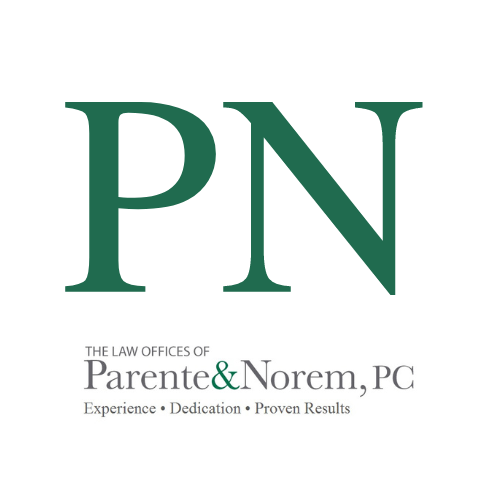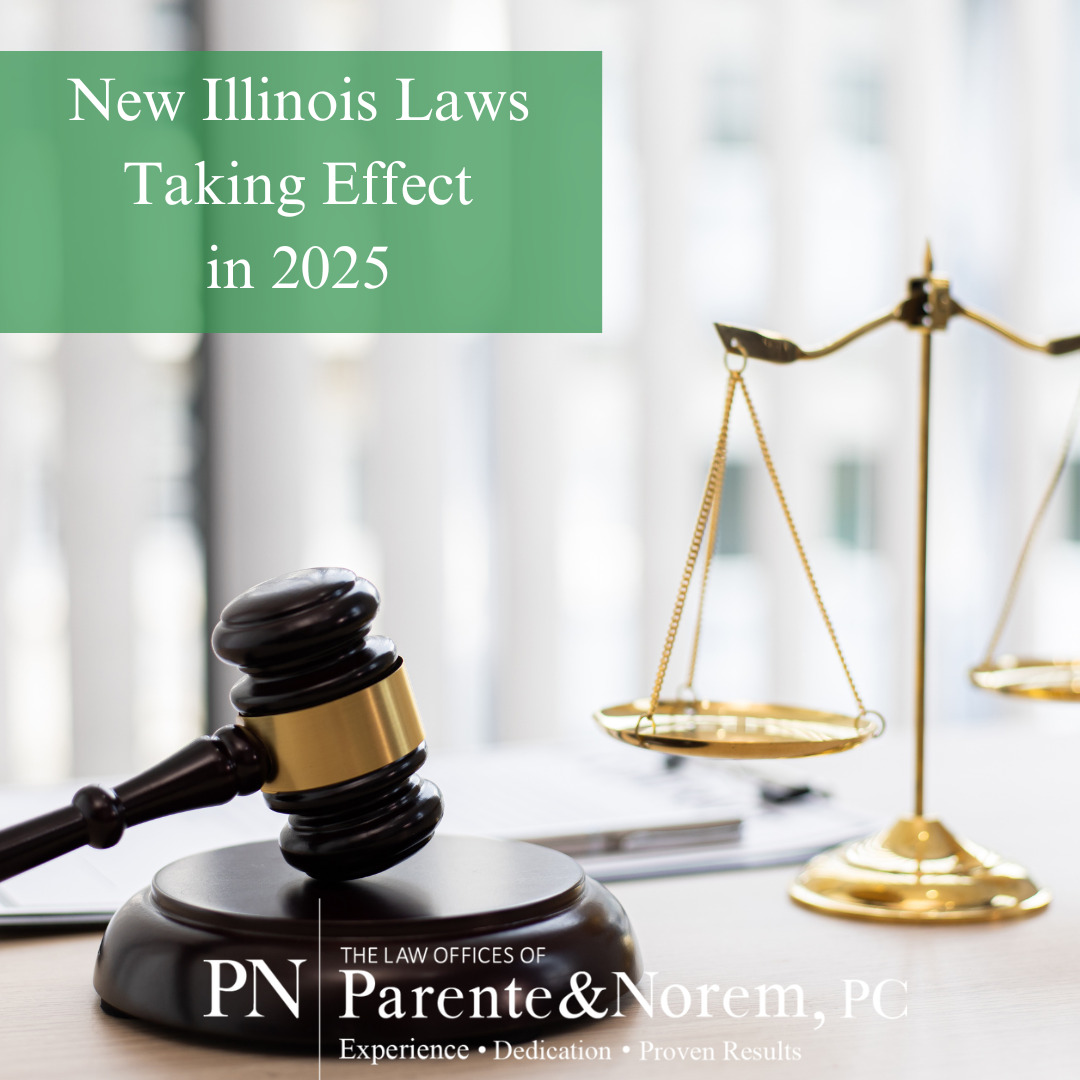
P&N BLOG | New Illinois Laws Taking Effect in 2025
As the calendar turns to 2025, Illinois residents will experience the impact of hundreds of new laws. From minimum wage hikes to changes in digital ID issuance and subscription management, these updates cover several aspects of daily life. Here’s an overview of some key changes:
Minimum Wage Increases
Starting January 1, 2025, Illinois’ minimum wage will reach $15 per hour. Tipped workers will also see their minimum wage rise from $8.40 an hour to $9 an hour. The law ensures that tipped workers earn at least 60% of the state’s minimum wage, providing greater financial stability for many in the service industry.
Digital Driver’s Licenses and IDs
Under HB4592, Illinoisans can now opt for digital driver’s licenses and IDs. While physical IDs remain available, the state is introducing a smartphone application to register digital versions, with a maximum fee of $6. However, private entities and agencies are not required to accept digital IDs, so physical copies may still be necessary in some situations.
Simplified Gym Membership Cancellations
HB4911 offers more convenience for gym-goers by allowing memberships to be canceled online, via email, or over the phone. This change eliminates the hassle of in-person cancellations.
Subscription Renewal Transparency
SB2764 protects consumers by requiring businesses to notify customers at least three days before an automatic renewal kicks in following a free trial period of 15 days or more. This measure aims to prevent surprise charges and encourage mindful spending.
Expunging Criminal Records
SB3463 amends the Juvenile Court Act, mandating the automatic expungement of juvenile criminal records two years after sentence completion. Expungement hearings will now be scheduled at the time of release, accelerating the process for justice-impacted individuals.
Regulations on Artificial Intelligence
- Child Pornography Laws: HB4623 ensures Illinois’ child pornography laws apply to AI-generated images and videos.
- AI Digital Replicas: HB4875 prohibits the use of unauthorized AI-generated digital replicas in certain content.
- Fair AI in Hiring: HB3773 bars employers from using AI-powered predictive analytics to consider an applicant’s race or zip code when making hiring or firing decisions.
Pay Transparency in Job Postings
An amendment to the Equal Pay Act requires Illinois employers with 15 or more employees to disclose salary ranges and benefits in all job postings. The law applies to remote positions performed in Illinois and includes a 14-day grace period for compliance before fines of $500 are imposed.
Workplace Freedom of Speech
Under SB3649, the Worker Freedom of Speech Act protects employees from disciplinary action for not attending mandatory workplace meetings discussing political or religious views. Nonprofit and advocacy organizations are exempt from this rule.
Preventing Catalytic Converter Thefts
HB4589 targets catalytic converter thefts by requiring recyclers to record vehicle identification numbers (VINs) and obtain proof of ownership from sellers.
Enhanced Protections Under Scott’s Law
HB5370 strengthens Scott’s Law, requiring drivers to change lanes or reduce speed when approaching emergency scenes, stopped emergency vehicles, or construction zones.
Employment Verification Standards
HB0508 prohibits employers from suspending or terminating employees due to discrepancies with E-Verify and bars additional verification requirements beyond federal mandates.
Child Abuse Awareness
HB4350 creates the Child Abuse Notice Act, requiring businesses like schools, daycare centers, hospitals, and bus stations to post notices informing children about physical and sexual abuse and how to report it.
Updated Language in Criminal Justice
An amendment to the Illinois Crime Reduction Act replaces the term “offenders” with “justice-impacted individuals.” The law also establishes the Adult Redeploy Illinois Oversight Board to assist reintegration into public life post-incarceration.
These legislative updates reflect Illinois’ efforts to address economic fairness, consumer protection, public safety, and inclusivity. Stay informed to ensure compliance and take advantage of the benefits these new laws provide.

P&N BLOG | Tips For Staying Safe This New Year’s Eve
New Year’s Eve is a time for celebration, but it’s also one of the most dangerous nights of the year to be on the road—or even walking near one. Statistics from the Centers for Disease Control (CDC) reveal that nearly half of all fatal car crashes on New Year’s Day involve drunk drivers. Late night celebrations combined with drinking and driving make this holiday particularly hazardous. Tragically, it’s also one of the deadliest days for pedestrians crossing the street.
As the clock strikes midnight and celebrations wind down, millions of people hit the roads to head home. The sheer volume of traffic, coupled with impaired drivers, creates a perfect storm for accidents. More than 50% of crashes on New Year’s Day involve high blood alcohol concentrations. Law enforcement agencies across the country respond with initiatives like the Drive Sober or Get Pulled Over campaign, which emphasizes education and rigorous enforcement to keep the roads safer.
At The Law Offices of Parente & Norem, we want you and your loved ones to start the New Year safely. Here are our top safety tips to protect yourself and others.
Essential Road Safety Tips
- Always Wear Your Seatbelt
Seatbelts save lives. According to the National Highway Traffic Safety Administration (NHTSA), seatbelt use saved nearly 15,000 lives in 2017 alone. - Secure Children Properly
Ensure kids are buckled into age and size appropriate car seats in the back seat. These measures can reduce serious injuries to children by 50%. - Obey Speed Limits
Speeding contributes to many fatal accidents and is entirely preventable. Drive within the posted limits. - Avoid Distractions
Put down your phone, avoid adjusting the radio, and don’t eat or groom while driving. Anything that takes your focus off the road, even briefly, increases the risk of an accident. - Plan Ahead
Arrange for a designated driver, book a hotel, or schedule a ride via shuttle, limo, or rideshare services like Uber or Lyft. - Consider Sober Ride Programs
Many cities offer free or low-cost sober ride programs during the holidays. Research your local options and share them with friends. - Use Public Transportation
Buses, trains, and other public transit options can be reliable and safe alternatives to driving. - Secure Your Vehicle
If you need to leave your car overnight, park in a well-lit, populated area. Lock your doors and keep valuables out of sight. - Drink Responsibly
Even small amounts of alcohol can impair judgment, reaction times, and vision. Avoid driving if you’ve had anything to drink, and remember that prescription drugs can also impair driving abilities. - Call for Help if Necessary
If you’re unable to secure a ride home, call 311 for assistance. It’s better to seek help than risk an accident.
Involved in a Drunk Driving Accident? Help Is Available
Unfortunately, even with precautions, accidents happen. If you or a loved one is involved in a drunk driving-related incident, it’s critical to act quickly. The experienced attorneys at The Law Offices of Parente & Norem are here to help. We understand the complexities of personal injury law and are committed to securing justice for our clients.
Contact us for a free consultation by calling 312.641.5926 or fill out a contact form here on our website. Don’t let the poor decision-making of an intoxicated driver ruin your New Year.
Stay safe, make smart choices, and let’s all work together to ensure a happier, healthier start to the year!
Source: [American Safety Council – New Year’s Eve Safety Tips]
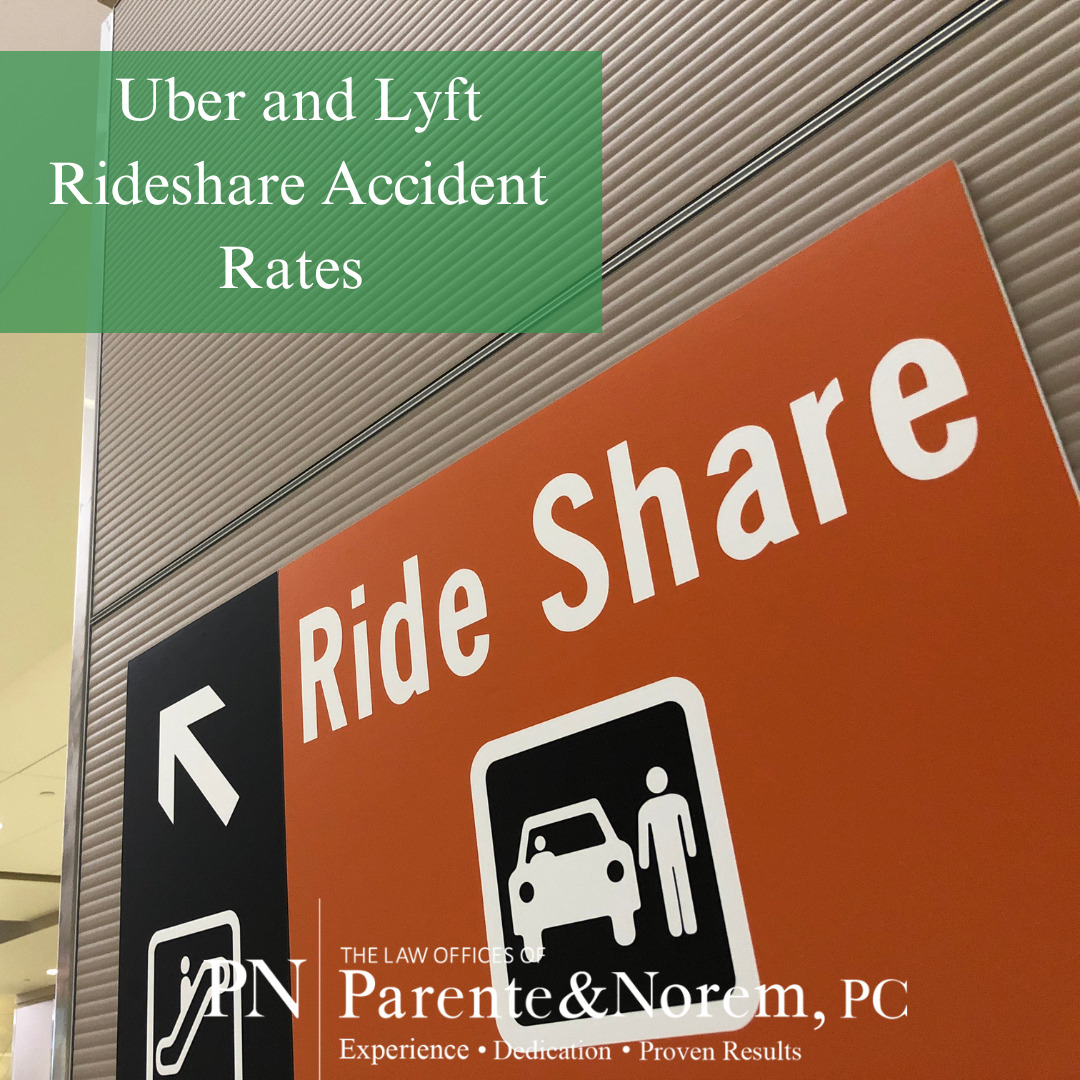
P&N BLOG | Uber and Lyft Rideshare Accident Rates
Ridesharing services like Uber and Lyft have revolutionized transportation, offering convenience, affordability, and accessibility. Millions of people rely on these platforms daily, but with their rapid rise, safety concerns have also come to the forefront. By examining accident rates from 2020 to today, we can shed light on the safety of rideshare services, the factors contributing to incidents, and what companies are doing to enhance safety for both passengers and drivers.
The Safety Concerns Surrounding Ridesharing
Ridesharing platforms have become staples of urban mobility, but the increased presence of Uber and Lyft vehicles on the road has raised important questions about safety. Several factors can influence rideshare accident rates, including:
- Driver Behavior: Speeding, distracted driving, and fatigue are common issues among rideshare drivers, many of whom work long hours.
- Road Conditions: Hazards such as poor weather, construction zones, or damaged roadways increase the likelihood of accidents.
- Other Drivers: Rideshare accidents often involve third-party drivers engaging in reckless or negligent behavior.
- Vehicle Maintenance: Mechanical failures, such as brake or tire issues, can play a role in rideshare accidents.
- Passenger Behavior: Distracted or disruptive passengers may unintentionally contribute to dangerous situations.
The Numbers Behind Rideshare Accidents
Uber and Lyft have marketed themselves as safe alternatives to traditional transportation, particularly by reducing incidents of drunk driving. Studies support this claim to an extent, showing decreased DUI rates in areas where ridesharing is prevalent. However, rideshare services are not without risks.
Key Statistics:
- Research from the University of Chicago attributes a 3% annual increase in traffic fatalities to the rise of rideshare services, equating to approximately 987 roadway deaths each year.
- Uber’s safety reports indicate that nearly 100% of rides between 2019 and 2020 concluded without safety incidents. Still, 0.0002% of trips involved critical safety events.
- Between 2017 and 2018, Uber vehicles were involved in 97 fatal crashes, resulting in nearly 110 deaths. Passengers, drivers, and third parties each accounted for significant portions of these fatalities.
- Lyft’s data echoes similar trends, with slightly lower accident involvement rates compared to Uber.
The Impact of the Pandemic on Ridesharing:
The COVID-19 pandemic brought significant shifts in transportation trends. While public transit usage in the U.S. dropped by 53%, Uber trips declined by only 27%, signaling a growing preference for ridesharing over traditional public transportation. This shift may have long-term implications for urban traffic patterns and safety dynamics.
What Are Uber and Lyft Doing About Safety?
Both Uber and Lyft have made efforts to increase transparency and improve safety through regular safety reports. These reports outline accident statistics, fatality rates, and initiatives aimed at mitigating risks. Key safety measures include:
- Enhanced Driver Screening: Comprehensive background checks and driving history reviews.
- In-App Safety Features: Emergency assistance buttons, real-time location sharing, and ride verification tools.
- Driver and Passenger Education: Awareness campaigns about seatbelt use, proper behavior, and adherence to road safety laws.
Government Oversight and Safety Regulations
Government agencies like the National Highway Traffic Safety Administration (NHTSA) monitor rideshare accident rates and enforce safety standards. These agencies play a vital role in analyzing data, conducting investigations, and implementing regulations to improve rideshare safety.
Injured in a Rideshare Accident? We Can Help.
Rideshare services have undeniably transformed how we travel. While they offer a convenient and cost-effective alternative to traditional transportation, safety concerns persist. Whether you’re a passenger, driver, or third party affected by a rideshare accident, it’s crucial to understand your legal rights.
If you or a loved one has been injured in an Uber or Lyft accident, contact The Law Offices of Parente & Norem, P.C. at 312.641.5926 today. Call or text us for a free case evaluation, or fill out the contact form on our website.
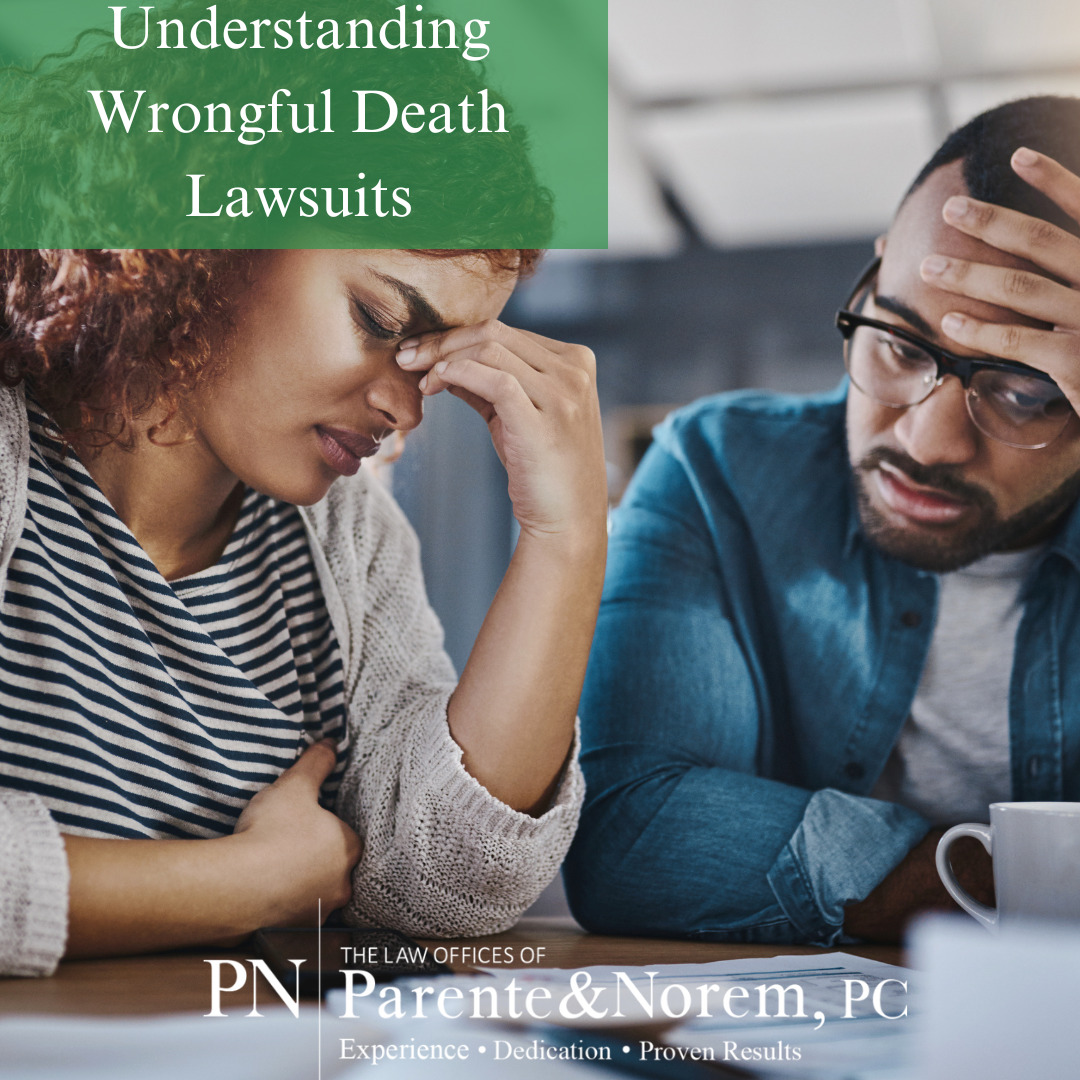
P&N BLOG | Understanding Wrongful Death Lawsuits
Losing a loved one is an unimaginable hardship, especially when their death is caused by someone else’s negligence or misconduct. In such cases, a wrongful death lawsuit can provide grieving families with the justice and financial compensation they deserve. At The Law Offices of Parente & Norem, we are here to help you navigate this challenging process.
What Is a Wrongful Death Lawsuit?
A wrongful death lawsuit is a civil action filed by the family or estate of a person who has passed away due to another party’s negligence, recklessness, or intentional misconduct. This legal process aims to compensate the deceased’s family for their loss, including:
- Medical expenses and burial costs
- Loss of income the deceased would have provided
- Pain and suffering endured by surviving family members
Who Can File a Wrongful Death Lawsuit?
In most cases, the personal representative of the deceased’s estate has the right to file a wrongful death lawsuit. A personal representative is often named in the deceased’s will or appointed by the court if no will exists. While this role is typically filled by a close family member, some states impose restrictions on non-family members serving as personal representatives. Be sure to consult local laws or seek legal advice to understand the rules in your jurisdiction.
Why You Need an Attorney for a Wrongful Death Case
Wrongful death lawsuits are complex, requiring a deep understanding of both the law and the specific circumstances of the case. Here’s how an experienced attorney can help:
- Navigating the legal process: Your attorney will guide you through each step, ensuring no critical detail is overlooked.
- Building a strong case: Attorneys know what evidence is needed; such as medical records, witness statements, or accident reports, and how to present it effectively.
- Maximizing compensation: A skilled lawyer will advocate for fair compensation, taking into account all damages and losses.
Types of Damages in Wrongful Death Cases
The compensation awarded in a wrongful death lawsuit often includes two primary categories of damages:
Compensatory Damages:
-
- Funeral and burial costs
- Medical expenses related to the accident or illness
- Loss of income and financial support
- Loss of companionship and emotional suffering
Punitive Damages: In cases involving gross negligence or intentional harm, courts may award additional damages to punish the at-fault party and deter similar behavior.
Preparing for a Wrongful Death Lawsuit
To build a strong case, it’s crucial to gather evidence promptly. This may include:
- Photos or videos of the incident
- Police reports or witness statements
- Medical and financial records
By acting quickly, you ensure that valuable evidence is preserved and the statute of limitations does not expire.
Choosing the Right Attorney for Your Case
Selecting the right attorney is a vital step in pursuing a wrongful death lawsuit. Here are some tips:
- Research thoroughly: Look for attorneys with proven experience handling wrongful death cases.
- Schedule consultations: Use these meetings to ask questions about their approach and track record.
- Read reviews and testimonials: Client feedback can offer valuable insight into an attorney’s reputation and success rate.
Common Mistakes to Avoid
To improve your chances of a favorable outcome, avoid these common pitfalls:
- Delaying evidence collection: Time-sensitive evidence, such as witness statements or physical evidence, can be lost if not secured promptly.
- Failing to meet deadlines: Missing filing deadlines due to statute of limitations laws can prevent you from pursuing your case.
- Going without legal representation: Without an experienced attorney, navigating the complexities of a wrongful death lawsuit can be overwhelming.
Understanding the Costs and Outcomes
While wrongful death lawsuits can involve significant costs, including attorney fees and court expenses, many firms (like ours) operate on a contingency fee basis. This means you pay nothing upfront, and we only collect fees if we win your case.
Outcomes vary based on the specifics of the case, with most cases resulting in a settlement. However, if a trial is necessary, we will fight tirelessly to secure the compensation you deserve.
Contact Us Today for Help
If you have lost a loved one due to someone else’s negligence, you don’t have to face this journey alone. At The Law Offices of Parente & Norem, we’re committed to standing by your side every step of the way.
Call/text us at 312-641-5926 or fill out our online contact form to schedule a free consultation. We’re available to discuss your case and provide the compassionate support you need.
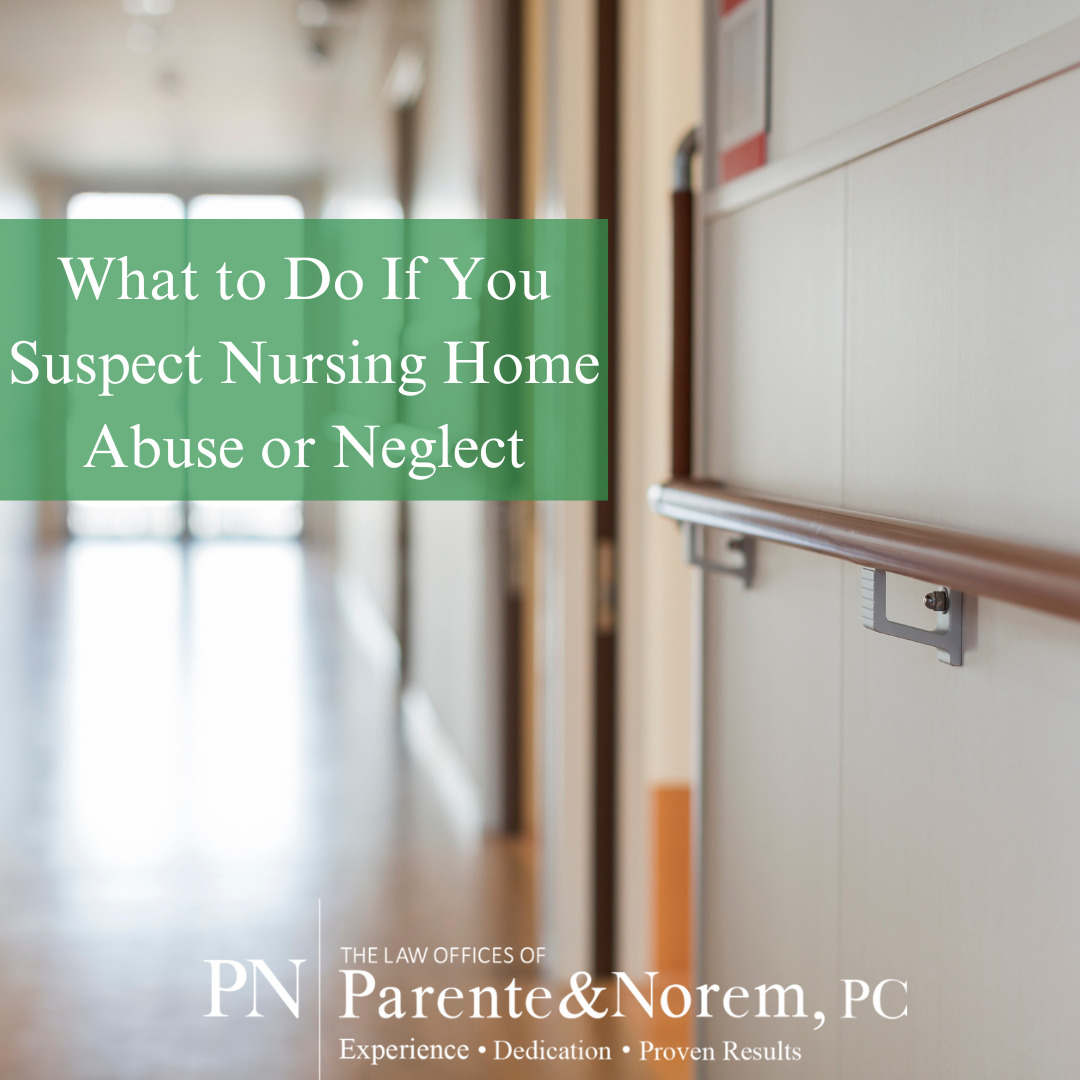
P&N BLOG | What to Do If You Suspect Nursing Home Abuse or Neglect
What to Do If You Suspect Nursing Home Abuse or Neglect
Choosing a nursing home or long-term care facility for a loved one is a deeply personal and often difficult decision. While these facilities should provide safety and care, the unfortunate reality is that nursing home abuse and neglect are more common than many realize. If you suspect that your loved one may be a victim, knowing what steps to take can make all the difference.
Understanding Nursing Home Abuse and Neglect
Nursing home abuse can take many forms: physical, emotional, sexual, or financial. Neglect, on the other hand, occurs when residents are not provided with the care they need to maintain their health and well-being. Both are serious and can have devastating consequences for your loved one.
Common signs of abuse or neglect include:
- Unexplained injuries: Bruises, burns, or cuts that cannot be adequately explained.
- Bedsores or hygiene issues: Indicators of neglect in daily care.
- Behavioral changes: Withdrawal, fearfulness, or other sudden emotional shifts.
- Unusual financial activity: Missing belongings or unauthorized transactions.
- Malnutrition or dehydration: Poor physical condition due to insufficient care.
Steps to Take if You Suspect Abuse or Neglect
If you believe your loved one is a victim of nursing home abuse or neglect, take these critical steps:
1. Document the Signs
Start by carefully observing and recording any signs of abuse or neglect. Maintain a detailed log, including photographs, videos, and written descriptions. Include the date and time of each incident, as well as any relevant names of staff members. These records will be crucial if you need to pursue legal action.
2. Report to the Nursing Home Administration
Bring your concerns to the nursing home administration, such as the administrator or director of nursing. Present your documented evidence and request immediate action.
If you are uncomfortable reporting to the facility or believe they are not addressing the issue, contact the Illinois Department of Public Health (or the appropriate regulatory body in your state). These agencies are responsible for investigating abuse and neglect complaints.
3. Consult with an Attorney
An experienced nursing home abuse attorney can help you navigate this challenging situation. At The Law Offices of Parente & Norem, P.C., we understand the complexities of these cases and can guide you through filing a complaint, pursuing legal action, and protecting your loved one’s rights.
4. Consider Relocating Your Loved One
If you believe your loved one’s safety is at risk, consider moving them to another facility. This ensures their well-being while the investigation or legal process is underway.
5. Follow Up and Monitor the Situation
Stay vigilant even after addressing your concerns. Regular visits and open communication with staff can help ensure your loved one continues to receive the care and respect they deserve.
Taking action when you suspect nursing home abuse or neglect is vital to protecting your loved one and holding facilities accountable. By documenting the signs, reporting your concerns, seeking legal assistance, and staying involved, you can help ensure your loved one’s safety and well-being.
If you suspect your loved one is a victim of nursing home abuse or neglect, our team at The Law Offices of Parente & Norem, P.C. is here to help. Call or text us at 312.641.5926, or fill out the contact form on our website to schedule a consultation.

P&B BLOG | Thanksgiving 2024 Road Travel Forecast
This Thanksgiving, the U.S. is set to experience record-breaking travel numbers, with an estimated 79.9 million people journeying 50 miles or more between November 26 and December 2. Of these, 71.7 million will travel by car, marking a 1.8% increase over last year. Here’s what you need to know if you’re hitting the road:
Busiest Travel Days
- Tuesday, November 26 and Wednesday, November 27 are predicted to be the most congested days. The worst times to travel are in the afternoon (1 PM to 7 PM), as commuters mix with holiday travelers.
- If possible, plan to drive during off-peak hours: before 10 AM on these days or on Thanksgiving morning itself, when traffic tends to be light.
Regional Traffic Insights
- The Chicagoland Area is expected to see the highest amount of congestion along its main arteries and interstate highways, especially I90, I94, and I55. Also expect delays around both O’Hare and Midway airports.
- Major cities like New York, Boston, Los Angeles, Seattle, and Washington, D.C., are expected to see traffic levels more than double their usual volume. Routes like I-95 and I-5 could face significant delays.
- Traffic on the Sunday following Thanksgiving will also peak, especially in urban areas as travelers return home.
Tips to Beat the Traffic
- Use navigation apps that factor in real-time traffic conditions.
- Avoid peak travel times: early mornings and late evenings are often the best options for a smoother drive.
- Monitor weather reports, as wet or snowy conditions are forecasted in some regions, which could worsen delays.
Safety and Preparedness
- Check your vehicle for road readiness (tire pressure, fluids, and emergency kits).
- Only use alternate routes you are familiar with.
- Carry snacks, water, and entertainment for longer-than-expected delays.
- Stay updated with local news and traffic advisories.
By planning strategically, you can reduce stress and spend more time enjoying the holiday with family and friends. Stay safe and have a happy Thanksgiving!
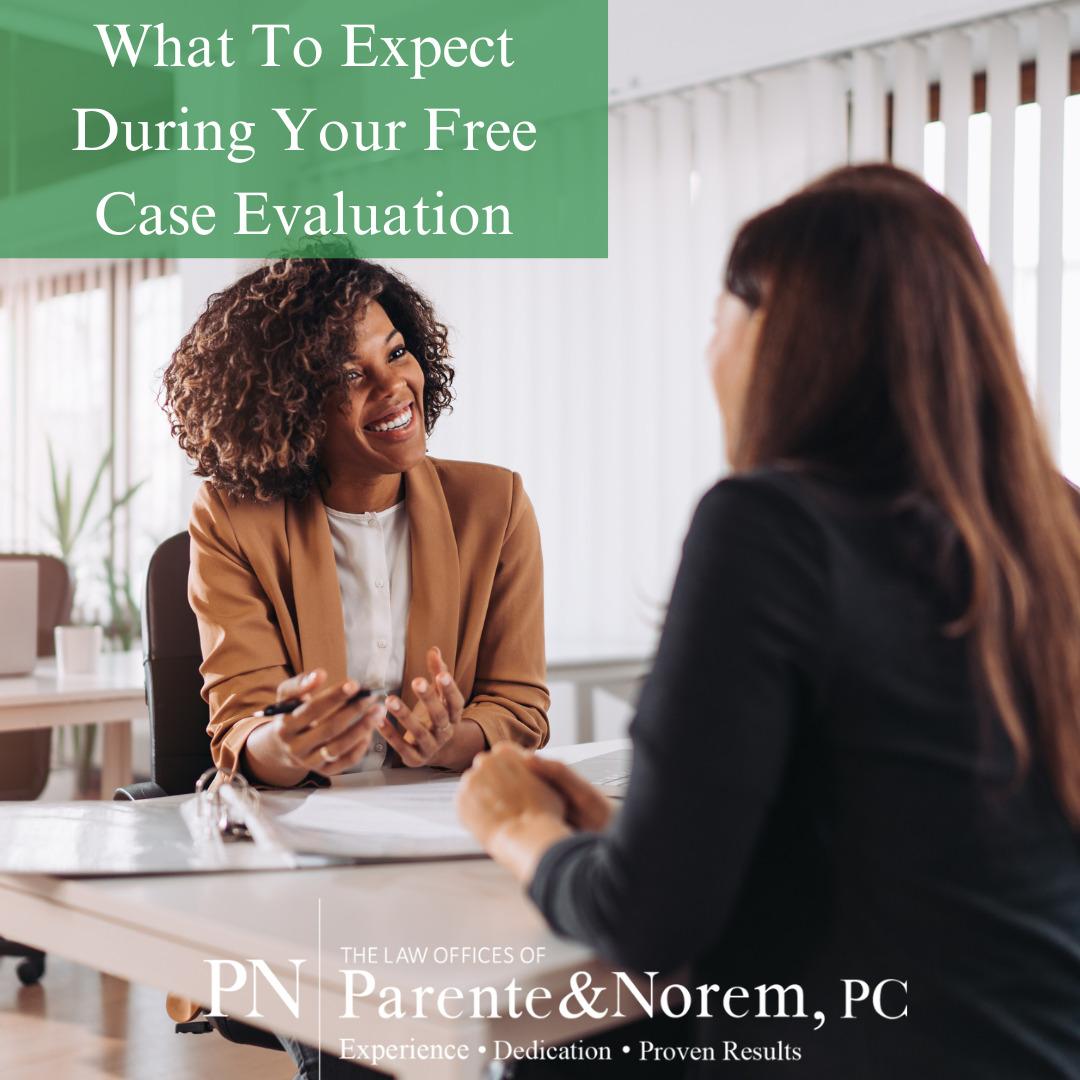
P&N BLOG | What To Expect During Your Free Case Evaluation
When you or someone you know has been injured due to negligence, the thought of hiring a personal injury attorney can be intimidating. At The Law Offices of Parente & Norem, P.C. we want to give you the confidence to reach out if you have any questions and want to see if you have a case to pursue. On today’s blog, let’s walk you through what a free case evaluation looks like at our firm.
Your First Call/Text or Contact Form
Whenever you reach out to Parente & Norem, your information is immediately given to our intake team. Outside of business hours, your contact information will be taken, and someone will reach out to you by the next business day. If it is during business hours, a member of the team will ask you some preliminary questions, and then ask you about the incident that left you injured. It’s important during this call to be as accurate and detailed as possible. You will need specific information like the date of the incident, who was involved, where the incident occurred, what happened, your specific injury and the medical treatment you have received thus far, any available police reports, incident reports, and insurance information. The more detailed and organized you can be before reaching out, the better.
Once your initial intake has been completed, it will be referred to the appropriate attorney based on the type of case it is. That attorney will then review the details that were given during your initial call, and reach out to you again if additional information is needed.
Next Steps
While the goal is always to start building your case immediately, it’s not unusual for some time to pass from your original call to when you are given the next steps. This can be for a myriad of reasons, but usually this is a period of information gathering to make sure our firm is a good fit for your case. During this time, you should continue to note everything going on as well as all of the medical treatment you are receiving.
Determining Whether or Not We Take Your Case
Several factors will contribute to whether or not Parente & Norem accepts your case. First and foremost our firm wants to make sure that we are the optimal attorneys to represent you for the best possible outcome. It is not our intention to pressure you into signing with our firm if it is not a case we can effectively represent.
If we decline to take you on as a client, it isn’t necessarily because you don’t have a case and you should continue your search.
When you’ve been injured, it never hurts to have an attorney look at your case. If you would like your own free case evaluation, call/text The Law Offices of Parente & Norem, P.C. at 312.641.5926 or fill out a free case evaluation form here on our website.
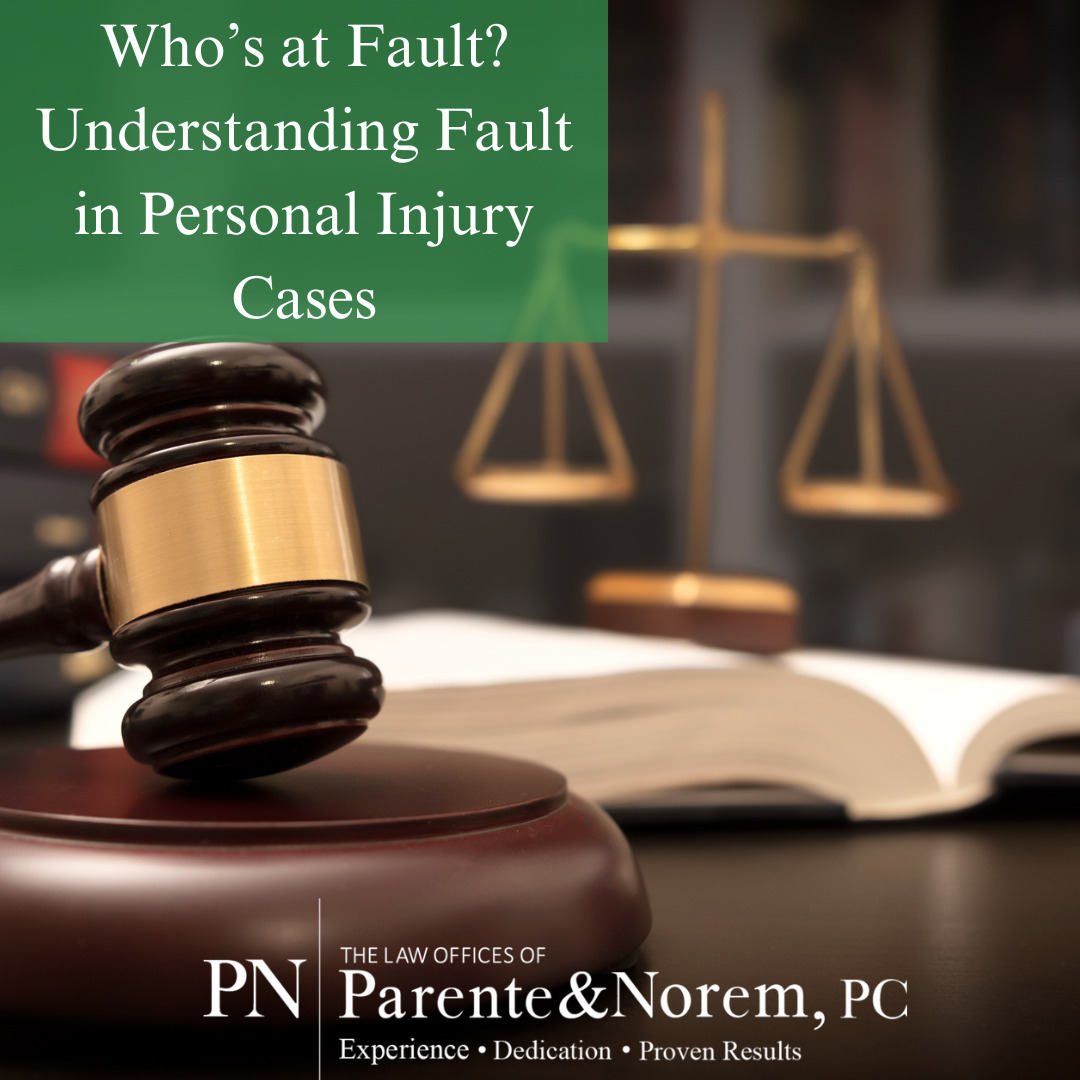
P&N BLOG | Who’s at Fault? Understanding Fault in Personal Injury Cases
When you’re injured due to someone else’s negligence, understanding who is legally at fault is critical for seeking compensation. Determining liability in personal injury cases can be complex, especially when more than one party shares responsibility. Here, we’ll outline the basics of how fault is determined and what factors come into play when multiple parties may be liable.
What is Negligence, and How Does It Relate to Fault?
Negligence is a legal term that refers to a failure to act with the care that a reasonable person would exhibit in similar circumstances. If someone’s negligence directly caused or contributed to your injury, they could be held liable for damages.
To prove negligence, your attorney will need to demonstrate:
Duty of Care: The responsible party owed you a duty of care (e.g., a driver has a duty to follow traffic laws).
Breach of Duty: They breached this duty by acting carelessly or irresponsibly.
Causation: Their actions directly caused your injury.
Damages: You suffered damages (financial, emotional, or physical) due to the injury.
How is Fault Determined in Personal Injury Cases?
Gathering Evidence: Fault determination starts with a thorough investigation of the circumstances leading to the injury. This may involve collecting police reports, witness statements, security footage, or photographs from the scene. Your attorney will use this evidence to paint a picture of how the incident occurred.
Identifying Liable Parties: It’s essential to identify all potentially responsible parties. In some cases, liability is straightforward, such as when a driver runs a red light and causes a collision. But in others, multiple parties may share responsibility; like in multi-vehicle accidents or situations where a property owner and an employee could both be held liable for a slip-and-fall accident.
Expert Witnesses: In some cases, your lawyer may bring in experts to determine fault. For instance, accident reconstruction experts can provide insights into a car accident, while safety experts might testify about proper protocols in a workplace injury.
Reviewing Legal Standards: Each state has specific rules about how fault impacts a personal injury case. For example, some states follow a “comparative negligence” standard, while others use “contributory negligence.” Understanding these legal standards is crucial in determining how much compensation you may be eligible for.
What Happens When Fault is Shared?
In some situations, more than one party may share the blame for an injury. States address shared fault in different ways, typically falling into one of the following categories:
Pure Comparative Negligence: In states with pure comparative negligence, each party is assigned a percentage of fault. You can recover damages even if you’re partially at fault, but your compensation will be reduced based on your level of responsibility. For instance, if you’re 30% at fault, your compensation will be reduced by 30%.
Modified Comparative Negligence: In states with modified comparative negligence, you can only recover damages if you’re less than 50% or 51% at fault, depending on the state. If you are found to be more than halfway responsible, you won’t receive any compensation.
Contributory Negligence: A few states still use contributory negligence, which is the most restrictive. Under this rule, if you are found to be even slightly at fault (even 1%), you cannot recover any compensation.
What to expect during the process of determining fault
The process of determining fault often includes several steps, which may vary depending on the complexity of the case. Here’s what you might expect:
Consultation with an Attorney: A personal injury lawyer will review the facts of your case and advise on your potential for recovery. They can help you understand the specific laws governing fault and your best course of action.
Case Investigation: Your lawyer will gather evidence, speak with witnesses, and work with experts to build a solid case showing the other party’s negligence.
Insurance Negotiations: Your lawyer will communicate with insurance companies to negotiate a fair settlement. Insurance adjusters may try to shift blame to reduce their payout, so having an attorney advocate on your behalf is essential.
Trial, if Necessary: If a fair settlement cannot be reached, your attorney may recommend taking your case to court, where a judge or jury will review the evidence and assign fault.
Why a Personal Injury Lawyer is Essential in Fault Determination
Personal injury lawyers understand the complexities of fault determination and have experience navigating cases where liability is disputed. They can help you maximize your compensation, even if you share some responsibility for the accident. Having a professional by your side ensures that every possible factor is considered, and your rights are protected.
Determining fault in a personal injury case can be complicated, but it’s essential for securing the compensation you need to recover. Whether another driver, a property owner, an employer, or multiple parties are responsible, an experienced personal injury lawyer can guide you through the process. By understanding how fault is shared and the legal standards that apply, you’ll be better equipped to pursue justice and move forward after an injury. If you or someone you know has been injured due to another’s negligence, call/text The Law Offices of Parente & Norem, P.C. today at 312.641.5926 today for a free case evaluation.
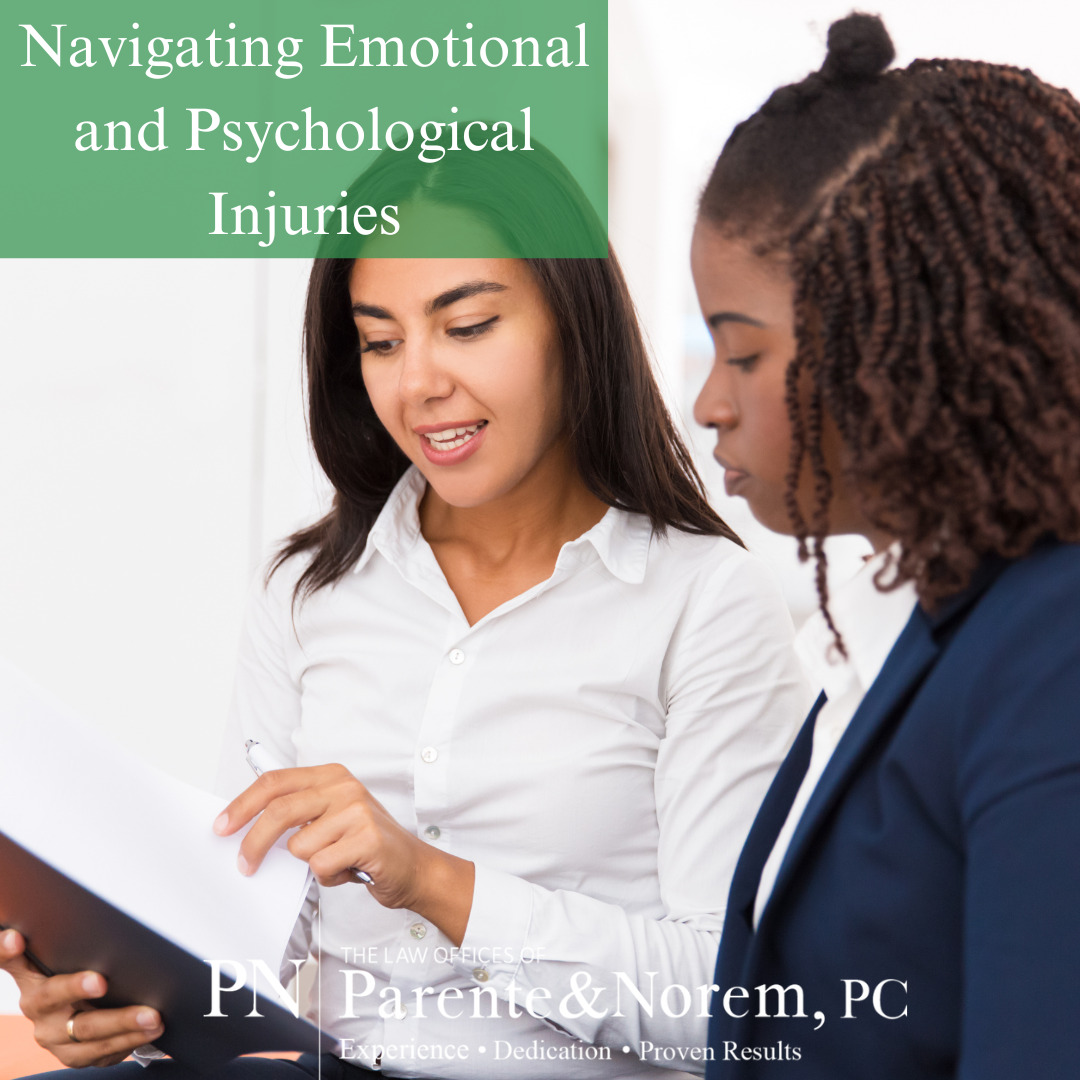
P&N BLOG | Navigating Emotional and Psychological Injuries
When people think of personal injury, physical damage often comes to mind—broken bones, bruises, or surgeries. However, what many don’t realize is that injuries can cut deeper than the physical. Emotional and psychological trauma are often silent but just as impactful. As a personal injury firm, we’re committed to helping our clients recover from all aspects of an injury, not just the visible ones.
Understanding Emotional and Psychological Trauma in Personal Injury Cases
Emotional and psychological injuries refer to the mental and emotional suffering that may follow a traumatic incident. These injuries can stem from any event that disrupts a person’s life, such as a car accident, workplace injury, medical malpractice, or other traumatic situations.
These hidden injuries can manifest in various ways, including:
Anxiety or panic attacks – A once-simple drive to work may now trigger overwhelming fear.
Depression – Feelings of hopelessness and sadness can take over, especially when facing the uncertainty of recovery or the loss of a loved one due to negligence.
Post-Traumatic Stress Disorder (PTSD) – A person may experience flashbacks, nightmares, or heightened anxiety following a traumatic event.
Sleep disturbances – Insomnia or disrupted sleep patterns are common after a traumatic incident.
Emotional instability – Anger, irritability, or emotional outbursts may occur more frequently.
It’s important to note that while a lot of feelings can emerge when you’ve been injured by another’s negligence, hurt feelings or ‘feeling disrespected’ do not qualify as emotional or psychological trauma.
Why Emotional and Psychological Injuries Matter
These hidden injuries can be just as debilitating as physical ones. Imagine trying to heal a broken leg while simultaneously dealing with crippling anxiety about driving or chronic depression. Emotional and psychological trauma can delay or complicate physical recovery, impact relationships, and even make it difficult for a person to return to work.
Ignoring these injuries can leave long-term scars. That’s why it’s essential to address them early and comprehensively. When left untreated, emotional trauma can evolve into chronic conditions that require long-term therapy or medication.
Recognizing Signs of Emotional and Psychological Trauma
As a personal injury client, it’s crucial to recognize the signs of emotional and psychological distress so you can seek the right kind of help. Here are some signs to watch for:
Changes in mood – Persistent feelings of sadness, irritability, or anger that don’t seem to pass.
Withdrawal – A desire to isolate from friends, family, or activities you once enjoyed.
Trouble focusing – Difficulty concentrating on tasks, work, or even conversations.
Hypervigilance – Constantly feeling on edge or overly aware of potential threats.
Physical symptoms – Headaches, stomach issues, and fatigue can often be related to emotional stress.
If you or someone you know is experiencing any of these symptoms following an injury, it’s important to seek help.
Injury recovery is about more than just mending broken bones or healing cuts—it’s about piecing back together your life and sense of well-being. Emotional and psychological injuries can be hidden and hard to talk about, but they are an essential part of your healing process. At The Law Offices of Parente & Norem, P.C., we’re committed to supporting you through the entirety of your recovery, ensuring that all aspects of your injury—physical, emotional, and psychological—are addressed.
If you or someone you love has been injured due to another’s negligence, call/text The Law Offices of Parente & Norem, P.C. at 312.641.5926 today for a free case evaluation.
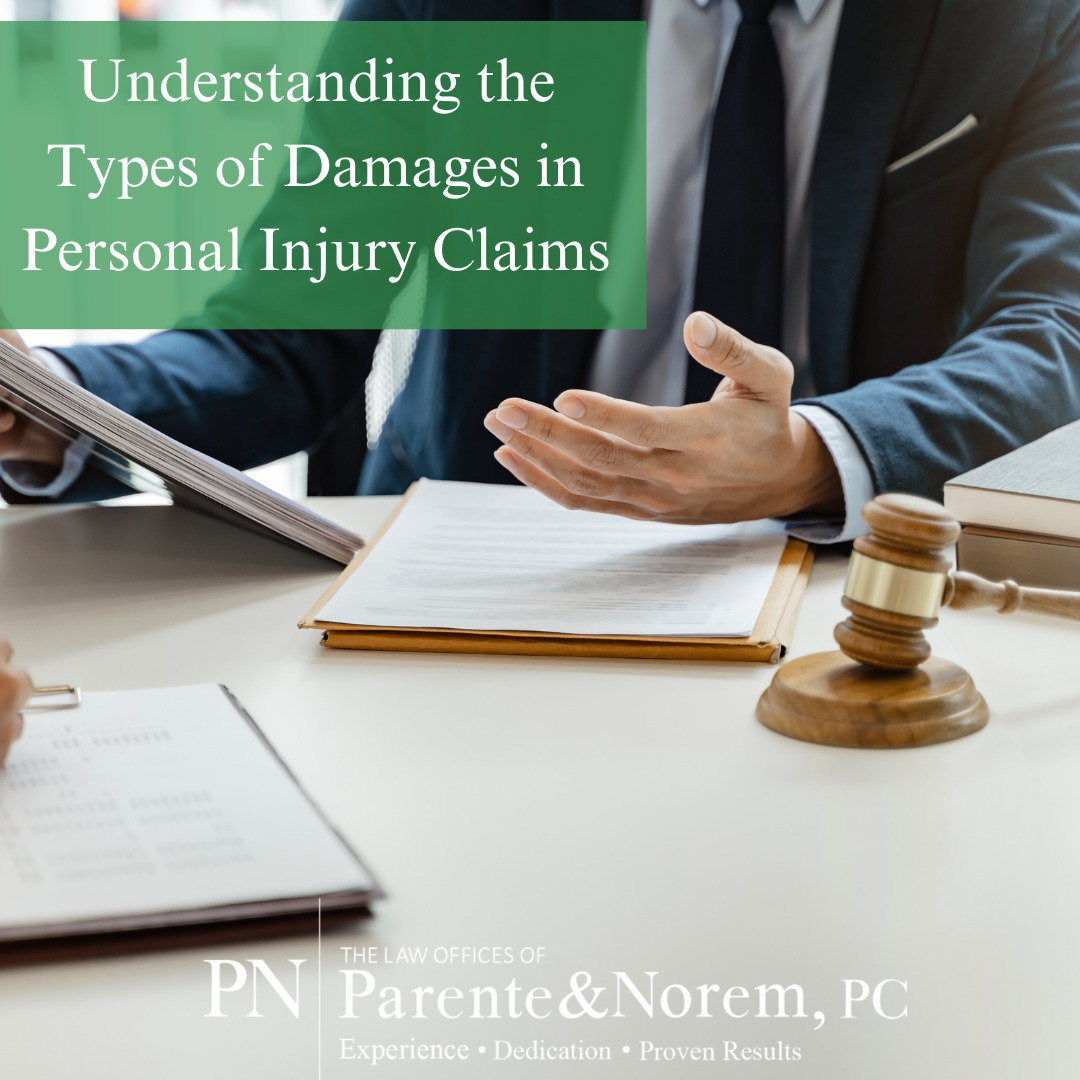
P&N BLOG | Understanding the Types of Damages in Personal Injury Claims
When individuals suffer harm due to accidents or negligence, they may be entitled to compensation through personal injury claims. These claims serve to restore the injured party, as much as possible, to their pre-accident condition by covering financial losses, emotional harm, and other negative impacts caused by the injury. If you’re pursuing a personal injury claim, it’s essential to understand the types of damages you may be entitled to. Below, we’ll explore the three main categories of damages; economic, non-economic, and punitive damages, and what each entails.
Economic Damages
Economic damages are tangible financial losses that result directly from the injury. They are intended to reimburse you for actual expenses and losses you’ve incurred or will incur in the future due to the accident. These damages are usually straightforward to calculate because they are based on documented costs such as bills, invoices, and pay stubs.
Examples of economic damages include:
Medical Expenses – This includes the cost of doctor visits, hospital stays, surgeries, rehabilitation, medications, and ongoing treatment needs. Future medical expenses can also be claimed if your recovery will require long-term care.
Lost Wages – If your injury prevents you from working, either temporarily or permanently, you can recover the income you’ve lost. This also includes future lost earning potential if you are unable to return to your previous occupation or work capacity.
Property Damage – In cases like car accidents, property damage covers the repair or replacement of your vehicle or other personal property involved in the incident.
Other Out-of-Pocket Costs – Expenses like transportation to medical appointments, assistive devices (such as wheelchairs), or home modifications for disability may also be covered.
Non-Economic Damages
While economic damages compensate for tangible losses, non-economic damages address the intangible impacts of an injury. These damages can be harder to quantify since they deal with emotional, psychological, and physical suffering caused by the incident.
Examples of non-economic damages include:
Pain and Suffering – This refers to the physical pain and discomfort endured as a result of the injury.
Emotional Distress – Accidents can leave victims dealing with anxiety, depression, or post-traumatic stress disorder (PTSD). Compensation for emotional distress accounts for these mental health impacts.
Loss of Enjoyment of Life – If the injury prevents you from participating in activities or hobbies you once enjoyed, you may be entitled to compensation for this diminished quality of life.
Loss of Consortium – In some cases, an injury can negatively impact the relationship between spouses or family members. Loss of consortium claims address the loss of companionship, affection, and support within these relationships.
Because non-economic damages are subjective, they often require the involvement of expert witnesses or testimony from therapists, family members, and the injured party to determine an appropriate value.
Punitive Damages
Punitive damages are awarded in cases where the defendant’s actions were particularly reckless, malicious, or intentional. Unlike economic and non-economic damages, punitive damages are not meant to compensate the victim but to punish the wrongdoer and deter similar conduct in the future. These damages are less common and typically only awarded in extreme cases, such as drunk driving accidents or instances of gross negligence.
Punitive damages vary significantly by jurisdiction, and some states place limits or caps on the amount that can be awarded. A skilled personal injury attorney can advise whether your case qualifies for punitive damages based on the specific circumstances.
Why It’s Important to Work with a Personal Injury Attorney
Understanding the types of damages you may be entitled to is critical for maximizing your personal injury claim. Calculating these damages; especially non-economic and punitive damages, can be complex and often requires experienced legal guidance. A personal injury attorney will not only ensure that all applicable damages are identified but also gather the necessary evidence to support your claim, including medical records, expert testimony, and financial documentation.
Additionally, insurance companies often try to settle claims for less than they are worth, particularly when non-economic damages are involved. Having a lawyer by your side helps level the playing field, ensuring you receive fair compensation for your injuries and losses.
If you or a loved one has been injured due to someone else’s negligence, understanding the different types of damages available is crucial for recovering the compensation you deserve. Economic damages cover your out-of-pocket losses, non-economic damages address your emotional and psychological suffering, and punitive damages may apply in extreme cases. An experienced personal injury attorney can evaluate your case, identify all applicable damages, and advocate for your best interests to achieve a fair settlement or court award.
At The Law Offices of Parente & Norem, P.C., we specialize in personal injury cases and are dedicated to helping our clients rebuild their lives after an accident. Contact us today at 312.641.5926 for a free consultation and learn how we can assist you in your pursuit of justice and compensation.
